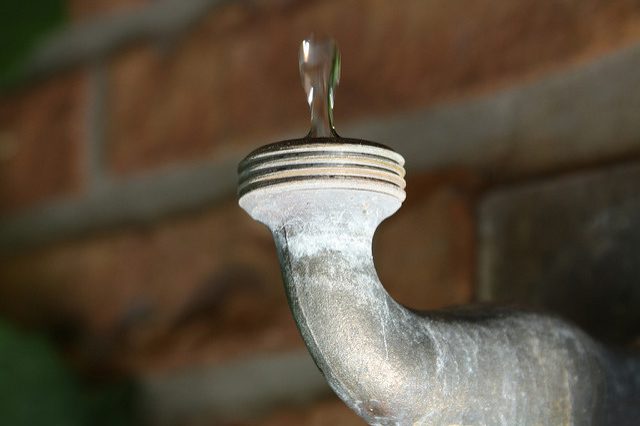
‘Leaky Faucet’ by Martin Van Damme via flickr, CC BY 2.0.
There’s a lot of talk about how homes will “filter down.” The argument goes that building new luxury housing will allow the wealthiest people to move into new housing, and (if the supply outstrips demand), eventually what had been high-end housing will command less money and will “filter down” to be affordable to lower income levels. Just how well this works, for whom, and how quickly is the subject of much debate, which I won’t wade into right now.
But here’s the thing we don’t talk about enough: developing affordable housing in a tight, high-cost market also increases overall affordability through filtering! Just in the other direction—it trickles up.
In most places, the majority of people making 30 percent of area median income are paying 50 percent of their income or more on housing. This means they are currently occupying homes that would be actually affordable to people making 50 to 80 percent of the area median. Building a new unit of housing for those at 30 percent of AMI therefore would not only house the person living in it, but odds are high it would also free up a unit that’s affordable at 50 to 80 percent AMI. Ditto for adding units aimed at those all along the low and moderate income spectrum.
Clearly, we don’t know for sure who would take that freed-up unit (it might even be rehabbed and become more expensive)—but we don’t know under the “trickle down” theory either. We do know the new unit at least went to someone in need and the overall supply has increased. (In fact, as an affordable unit is more reliably going to be lived in as primary residence, building affordable housing increases overall supply a little bit faster than building the same number of luxury units.)
I’m not the first person to say this, of course—National Low Income Housing Coalition has made this argument to support subsidies specifically for adding units targeted to extremely low-income households and reforming the Low Income Housing Tax Credit to serve those households better.
It should be noted that in a weak market this does not necessarily work—if there are sufficient units at various low- and moderate-income price points to meet demand but they are of poor quality, new higher quality affordable homes for people who are already housed can lead to abandonment of poorly maintained housing. Affordability work in such areas is still needed, but will look different.
It Works
In strong markets, however, there’s a very noticeable positive ripple effect of adding new units for those at the lower incomes. Karen Chapple and Miriam Zuk of University of Cailfornia–Berkeley found in 2016 that “At the regional level, both market-rate and subsidized housing reduce displacement pressures, but subsidized housing has over double the impact of market-rate units” (emphasis added).
It also improves the match between home cost and jobs, which makes for a more balanced housing market.
The affordable housing field shouldn’t cede the “increasing the supply of housing” and “freeing up units through filtering” arguments to the luxury developers—or let them use those points against commitments to affordable housing. If housing is going to trickle, let it go up.





Thanks so much for this article! I’ve been making the same point here in the Bay Area where we hear a growing chorus of “trickle down” voices advocating for deregulation to “free up the market” and who say that if we just expand supply, everything will be better. Thanks also for referencing the Chapple and Zuk article, which really deserves more attention. It was stimulated in part by a desire to rebut the claims of the California Legislative Advocate Office that more supply will solve the problem. As if there were a single marking for undifferentiated housing as opposed to multiple, highly stratified markets that vary considerably in terms of both product type and location.
I think the theory of housing “filtering down” is actually that building luxury units will allow higher income households to move up, freeing the housing they were occupying, which theoretically is more affordable, for another, less affluent, household, and so on, until the extremely low income or possibly even homeless, can move up into an affordable housing unit. I don’t know if the luxury housing will also come down in price making it affordable to less wealthy people. Obviously, increasing the supply should reduce the price of all housing, unless there’s already a shortage.
Not at all wrong, but we can do both! We could let the market build for the high end of the market and government and nonprofits could build for the lower end.
Thank you, Miriam, for the caveat about low demand, weak market places where building new affordable housing or rehabbing vacants can actually be counterproductive and lead to abandonment of other lower quality units. A good example is the Sandtown revitalization project in Baltimore in the 1990’s where 600 units were built or rehabbed for affordable housing, and about 600 others went vacant. Tragically, some of the rehabbed vacants have gone vacant again and had to be re-rehabbed, and some are being demolished. Today, the neighborhood has even more vacancy than in the 1990’s. I hope this illustrates why rehabbing the plentiful vacants in a low demand, weak market as affordable housing sounds logical on a superficial level, but actually doesnt work and is not a good use of scarce housing subsidies. Other non-housing neighborhood investments are needed that improve quality of life and increase demand.